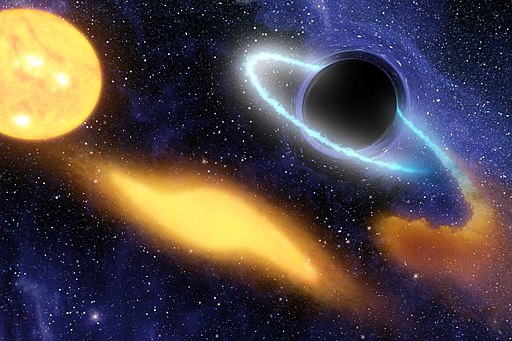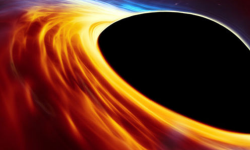
Until recently, it was thought that the central black hole of the Milky Way, called Sagittarius A*, was a small supermassive black hole. With 4 million solar masses, it is not one of the big supermassive black holes. Its activity seems weak, nothing to do with the overpowering quasars that can be observed in distant galaxies. A few months ago, we even realized that he has some energy flares. On May 13th, it was observed that Sagittarius A* infrared luminosity was briefly multiplied by 75, which is probably a sign that a significant amount of material had just dropped towards its event horizon. But this luminous burst is insignificant comparing to the cataclysm that a team of Australian researchers have discovered.
3.5 million years ago, that is to say very recently at the cosmic scale, the center of the Milky Way would have undergone a gigantic explosion that would have given birth to two visible X-ray and gamma rays protuberances, that extend up to 25,000 light-years from the center of the Milky Way. These protuberances are called FERMI bubbles because they were discovered by the FERMI space telescope about ten years ago. They are probably proof that the Milky Way has given birth to these rays very recently.
Australian researchers believe they have discovered additional evidence of this event in the Magellanic Stream, a trail of matter left behind in the wake of the Magellanic Clouds, two dwarf galaxies that orbit the Milky Way. Some parts of this stream seem to have been ionized by a very powerful source. Only a nuclear activity related to the central black hole of the Milky Way is a plausible source. In their models, a double ionizing cone originating from Sagittarius A* seems to correspond best with observations. In other words, a jet of rays would have occurred 3.5 million years ago and would have lasted about 300,000 years.
This event was certainly very bright and the ancestors of homo sapiens may have lived with a double cone of light in the sky. To produce such an incredible explosion, it certainly took a very important gas accretion around the black hole. Some stars that are suspected to have made close runs around Sagittarius A* at this time could complete this scenario. However, there is still a lot of work to do to understand how supermassive black holes influence their host galaxy.
If the scenario of the jets of rays is confirmed, the Milky Way would take a completely different face than we thought. It was an active galaxy only a few million years ago. It was able to produce other jets of rays whose light has not yet reached us. One can in any case be considered happy to live a few tens of thousands of light-years from the center of the galaxy. The stars and planets that were taken in the radiation cone and in the shock wave of the FERMI bubbles have been unlucky.

An atypical star would prove that the Milky Way has swallowed its cosmic neighbors
– News of May 14, 2019 –
The Milky Way is surrounded by dozens of dwarf galaxies like the Small and the Large Magellanic Cloud. There are clues that our galaxy has swallowed some of its smaller neighbors in its history. For example, data from the Gaia astronomy mission showed a group of tens of thousands of stars with strange behavior. They orbit the center of the galaxy in the opposite direction of the other stars, probably because they came from the fatal encounter with another galaxy ten billion years ago.
In the same way, a team of researchers think that star J1124+4535 did not form in the Milky Way, although it resides there henceforth. This time its chemical composition betrayed it. J1124+4535 was discovered in 2015 in the constellation Ursa Major. It is located about 60 000 light years from us. Observations from the Subaru Telescope have shown that it has very low levels of magnesium and high levels of europium. This chemical signature canno’t be found in its close stars, nor in the rest of the stars of the Milky Way.
The chemical composition of J1124+4535 is unique. This suggests that it was formed in an environment different from the rest of the stars of the Milky Way. This chemical signature is however quite typical of the stars that form in the dwarf galaxies close to the Milky Way. We can therefore assume that J1124+4535 was part of one of the twelve dwarf galaxies that were swallowed by the Milky Way. This is the most obvious chemical clue that such an event has taken place. We are now beginning to accumulate more and more evidence of this cosmic feast. Perhaps the different catalogs of Gaia will help us to reconstruct the whole history of the Milky Way in the coming years.
However, we must not think that these intergalactic assimilations will no longer take place. The Milky Way continues to swallow its neighbors. The great Magellanic Cloud that has tens of billions of stars could also be eaten by the Milky Way in 2.5 billion years. The Milky Way will continue to grow to meet stronger than she. It will meet the Andromeda galaxy in 4 to 5 billion years. It has long been thought that Andromeda was more massive than the Milky Way, but both galaxies seem to have a similar mass in the end. Their meeting will eventually create a super-galaxy. If today we have difficulties in tracing the history of the Milky Way, try to imagine the work that awaits a civilization that would appear in this new monster galaxy.
The Milky Way has a wavy shape
– News of February 10, 2019 –
When we imagine the Milky Way, we think of a rather flat disc. This is the shape we observe for surrounding galaxies. However, it is difficult to precisely determine the shape of a celestial object becaue we are part of that object. A Chinese-Australian team has created a map of our galaxy that contradicts this image of a flat disk. Distance measurement is a big part of the problem.
To try to model the Milky Way, we can try to accurately measure the distance to the sun from a sample of stars. Fortunately, we already know how to do it for a specific type of star. Cepheids are very young stars with variable brightness. By establishing a relation between their periodicity and luminosity, their distance can be estimated. But this method only works for fairly small distances on a cosmic scale. But on the galactic scale, it is quite reliable.
By creating a catalog of 1339 Cepheids, the research team realized that the outermost regions of the Milky Way seem to have an undulating form. The further from the galactic center, the more deformations are visible. This observation makes the Milky Way very interesting. The majority of spiral galaxies would indeed be flat, but some of them would have similar deformations.
A ghost galaxy discovered near the Milky Way
– News of December 4, 2018 –
On April 25, the second catalog of ESA’s Gaia Space Observatory was published. Gaia is installed around the L2 Lagrange point of the Earth-sun system. Gaia has listed the position, parallax and motion of more than 1.3 billion stars. Its results continue to lead to many discoveries.
An international team of researchers think they have detected a dwarf galaxy located on the outskirts of the Milky Way, with amazing features. The object is called Antlia 2. The Milky Way has several dozen satellite galaxies, dwarf galaxies of a few billion solar masses. The most important of these is the Large Magellanic Cloud that has been known to humanity for centuries. Antlia 2 is almost as tall as it is and almost one-third the size of the Milky Way.
However, this dwarf galaxy has not been discovered before 2018. Antlia 2 is located just behind the galactic disk, so it is hidden by the hundreds of billions of stars in the Milky Way. It is also incredibly dark, it is even nicknamed the ghost galaxy. Although it is almost the same size as the Large Magellanic Cloud, it is in fact 10,000 times less luminous than it is.
The large size and the very low luminosity of the dwarf galaxy are characteristics rather difficult to reconcile. We are still looking for a scenario to explain the current state of Antlia 2. The dwarf galaxy may have lost some of its stars in favor of the Milky Way. The problem is that galaxies that lose stars tend to shrink in size, we can also imagine that in its youth, Antlia 2 was the home of many supernova, who would have blown gas and dust outside the galaxy. But even this hypothesis fails to explain the characteristics of Antlia 2. We know that dark matter plays a proportionally greater gravitational role in dwarf galaxies, it is perhaps on this side that we must investigate.
For the moment, Antlia 2 is an exception among the known satellite galaxies of the Milky Way. On the other hand, it may be the first in a series of similar objects to be discovered. In this case, it may be necessary to review the formation models of dwarf galaxies. Gaia is the ideal tool to make this type of observations. The final catalog of the european observatory is expected to be published in 2022. It will fuel research on stars and galaxies for many years to come.
The Gaia mission reveals that the Milky Way has already struck the Sagittarius galaxy
– News of October 2, 2018 –
Gaia is an astrometry mission that records the position and other parameters of more than a billion stars. From the data catalog produced by the mission, a team of European researchers think they have reconstructed a small piece of our galactic history. We know that the Milky Way had a tormented past. It swallowed, merged and confronted its gravitational force with the other galaxies around her. Most of these encounters took place a long time ago, as evidenced by the relatively flat and regular shape of the galactic disk. But if you look at the behavior of stars in detail, it’s not as calm as it may seem.
The behavior of a group of a few million stars intrigued the team of European astronomers. These stars orbit the galactic center like all others, but they also follow more tormented patterns by spinning around each other. In observing these patterns, the team concluded that these were the consequences of a large gravitational disturbance that would have occurred between 900 and 300 million years ago. Only another galaxy could have had such an impact on so many stars. It is thought that this could be because of the dwarf galaxy Sagittarius, which is one of the many galaxies close to the Milky Way.
It follows a polar orbit around our galaxy, about 50 thousand light-years away. It contains a few tens of billions of stars. Previous research has already made the hypothesis that this galaxy has already found itself near the Milky Way a few hundred million years ago. Millions of stars on both sides would have been trapped in a gigantic gravitational game. The strange patterns found in Gaia’s data would therefore be the testimony of this distant past.
The duel between the Milky Way and the dwarf galaxy of Sagittarius is not over, and the Milky Way is winning. A simulation published this summer even estimates that the small satellite galaxy has only 100 million years to live before being destroyed by the Milky Way. It will join the dozen galaxies already swallowed by the Milky Way.
Image by Pixabay









